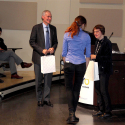Overview
 Organized by the Integrated Program in Neuroscience, the 2018 Bernice Grafstein Lecture in Neuroscience featured keynote speaker, Dr. Marc Tessier-Lavigne, Ph.D., President and Bing Presidential Professor at Stanford University (California). The 2018 lecture attracted more than 300 attendees province-wide, ranging from academics and the general public, to hear Dr. Tessier-Lavigne and his team's advanced work in neuroscience, and to meet Dr. Grafstein herself.
Organized by the Integrated Program in Neuroscience, the 2018 Bernice Grafstein Lecture in Neuroscience featured keynote speaker, Dr. Marc Tessier-Lavigne, Ph.D., President and Bing Presidential Professor at Stanford University (California). The 2018 lecture attracted more than 300 attendees province-wide, ranging from academics and the general public, to hear Dr. Tessier-Lavigne and his team's advanced work in neuroscience, and to meet Dr. Grafstein herself.
Dr. Tessier-Lavigne delivered his keynote lecture, which was titled, "Wiring and rewiring the brain: The logic and mechanisms of axon guidance and plasticity."
Keynote Address: Netrins and iDISCO
In the developing brain, axons navigate along specified pathways to appropriate targets by detecting specific molecular guidance cues. These include netrins, one of the first and best characterized guidance cue families, which have long provided a model for axon guidance. Recent studies have raised interesting questions about the precise roles and mechanisms of netrins in guiding axons at short- and long-range, which were addressed in the first part of the lecture. The second part described the team's development of a brain clearing technique, iDISCO, to facilitate study of axonal changes in the adult nervous system, and its use to elucidate the logic and mechanisms of axonal rearrangements under conditions of plasticity.
>> Watch the full lecture here
Dr. Marc Tessier-Lavigne
 A pioneering neuroscientist and leader in biotechnology and higher education, Marc Tessier-Lavigne became Stanford University’s 11th president on September 1, 2016. He returned to Stanford after serving for five years as president of The Rockefeller University, a leading graduate biomedical research university. Prior to his time in New York, he spent more than two decades in the Bay area. From 2001 to 2005, he served on the Stanford faculty as a professor of biological sciences and held the Susan B. Ford Professorship in the School of Humanities and Sciences. While at Stanford, he was recruited to Genentech, where he served as Executive Vice President for Research and Chief Scientific Officer, directing 1,400 scientists in disease research and drug discovery for cancer and other illnesses. Prior to Stanford, he served on the faculty at the University of California, San Francisco (UCSF), where he was recognized for distinguished teaching and ground-breaking discoveries on brain development. He is the recipient of numerous awards, including being elected as a member of the National Academy of Sciences, the National Academy of Medicine, and the American Philosophical Society. President Tessier-Lavigne earned undergraduate degrees from McGill University and from Oxford, where he was a Rhodes Scholar, and a Ph.D. from University College London. He performed postdoctoral work there and at Columbia University.
A pioneering neuroscientist and leader in biotechnology and higher education, Marc Tessier-Lavigne became Stanford University’s 11th president on September 1, 2016. He returned to Stanford after serving for five years as president of The Rockefeller University, a leading graduate biomedical research university. Prior to his time in New York, he spent more than two decades in the Bay area. From 2001 to 2005, he served on the Stanford faculty as a professor of biological sciences and held the Susan B. Ford Professorship in the School of Humanities and Sciences. While at Stanford, he was recruited to Genentech, where he served as Executive Vice President for Research and Chief Scientific Officer, directing 1,400 scientists in disease research and drug discovery for cancer and other illnesses. Prior to Stanford, he served on the faculty at the University of California, San Francisco (UCSF), where he was recognized for distinguished teaching and ground-breaking discoveries on brain development. He is the recipient of numerous awards, including being elected as a member of the National Academy of Sciences, the National Academy of Medicine, and the American Philosophical Society. President Tessier-Lavigne earned undergraduate degrees from McGill University and from Oxford, where he was a Rhodes Scholar, and a Ph.D. from University College London. He performed postdoctoral work there and at Columbia University.
Dr. Bernice Grafstein
 Dr. Grafstein received her B.A. in physiology at the University of Toronto and her Ph.D. in neurophysiology at McGill University in Montreal. Amongst her notable work in neuroscience, Dr. Grafstein is widely-known for being the first woman to become President of the Society of Neuroscience, and is currently a Trustee and Vice-President of the Grass Foundation, which supports training and research in neuroscience. She is Professor of Physiology & Biophysics and the Vincent & Brooke Astor Distinguished Professor in Neuroscience at Weill Cornell Medicine in New York City.
Dr. Grafstein received her B.A. in physiology at the University of Toronto and her Ph.D. in neurophysiology at McGill University in Montreal. Amongst her notable work in neuroscience, Dr. Grafstein is widely-known for being the first woman to become President of the Society of Neuroscience, and is currently a Trustee and Vice-President of the Grass Foundation, which supports training and research in neuroscience. She is Professor of Physiology & Biophysics and the Vincent & Brooke Astor Distinguished Professor in Neuroscience at Weill Cornell Medicine in New York City.
Photo Gallery
Credits: Dhabisha Kohilanathan

















